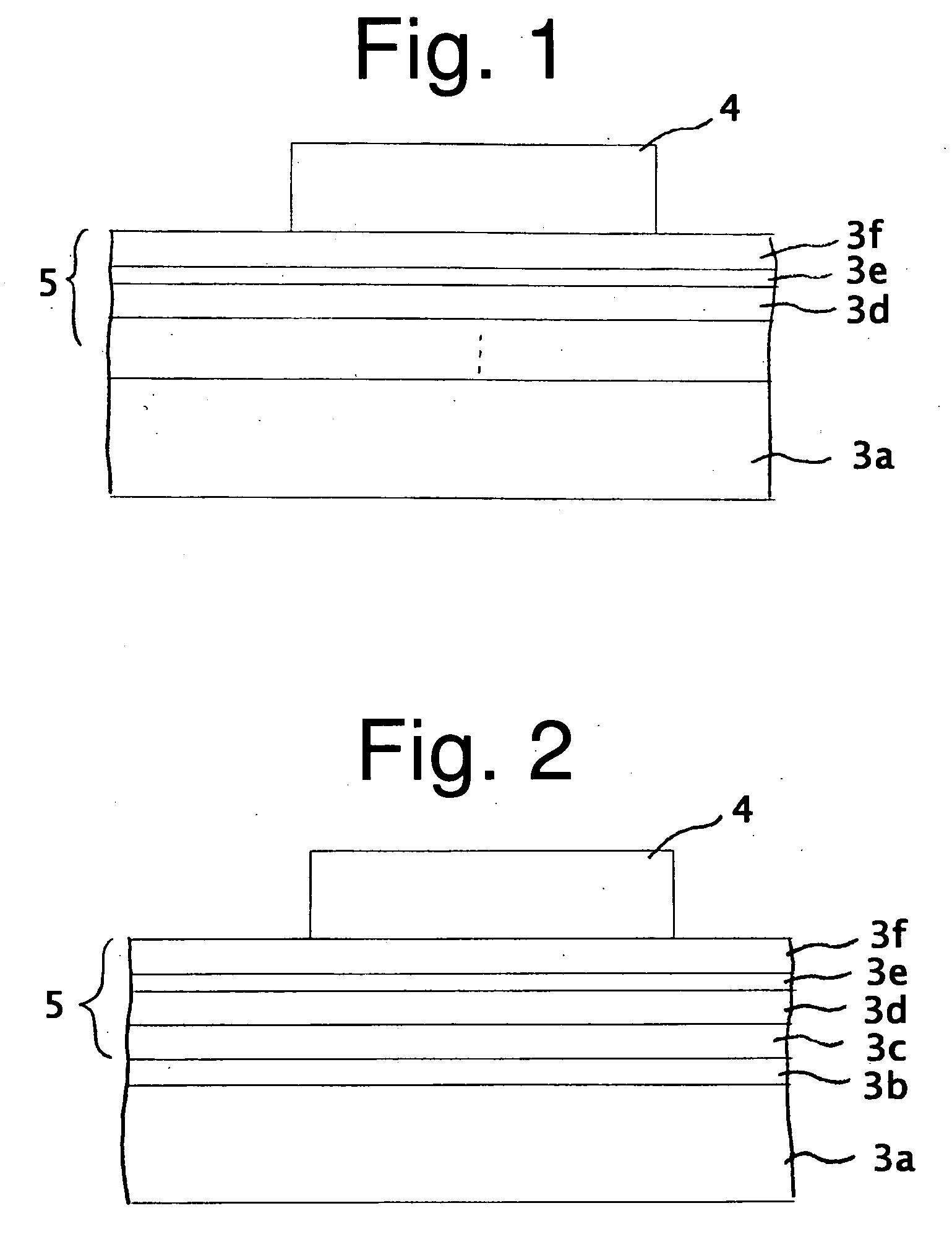Semiconductor Light emitting device, LED package using the same, and method for fabricating the same
- Summary
- Abstract
- Description
- Claims
- Application Information
AI Technical Summary
Benefits of technology
Problems solved by technology
Method used
Image
Examples
first example
[0080]In the first example, a metal film 5 was deposited on a flat silicon substrate with an oxide film. Its reflectance was measured before and after a heat aging test.
[0081]Specifically, the films were deposited on the silicon substrate with an oxide film under the following deposition conditions. A Ti film serving as an adhesion layer 3c was formed with an argon pressure of 1 Pa and a DC output of 1 kW to have a thickness of 75 nm. A Ni film serving as a barrier metal layer 3d was formed with an argon pressure of 0.2 Pa and a DC output of 1 kW to have a thickness of 250 nm. A Ti film serving as a metal layer 3e was formed with an argon pressure of 0.2 Pa and a DC output of 1 kW to have a thickness of from 0.35 to 300 nm (in particular, samples were prepared having the Ti film at thicknesses indicated by the data points in FIGS. 10 and 11, including 0.35 nm, 1 nm, 50 nm, 100 nm, 150 nm, 200 nm and 300 nm). (A control sample without a metal layer 3e was also prepared and is indicat...
second example
[0084]In the second example, a metal film 5 was deposited on a flat silicon substrate with an oxide film. Its reflectance was measured before and after the heat aging test.
[0085]Specifically, the films were deposited on the silicon substrate with an oxide film under the following deposition conditions. A Ti film serving as an adhesion layer 3c was formed with an argon pressure of 1 Pa and a DC output of 1 kW to have a thickness of 75 nm. A Ni film serving as a barrier metal layer 3d was formed with an argon pressure of 0.2 Pa and a DC output of 1 kW to have a thickness of 250 nm. A Pd film serving as a metal layer 3e was formed with an argon pressure of 0.2 Pa and a DC output of 500 W to have a thickness of from 1 to 1000 nm (in particular, samples were prepared having the Pd film at thicknesses indicated by the data points in FIGS. 12 and 13, including 1 nm, 100 nm, 300 nm, 500 nm and 1000 nm). (A control sample without a metal layer 3e was also prepared and is indicated by a Pd th...
third example
[0089]In the third example, a metal film was deposited on a flat silicon substrate with an oxide film. The substrate was then wire-bonded and subjected to a pulling-strength test.
[0090]Specifically, the films were deposited on the silicon substrate with an oxide film under the following deposition conditions. A Ti film serving as an adhesion layer 3c was formed with an argon pressure of 1 Pa and a DC output of 1 kW to have a thickness of 75 nm. A Ni film serving as a barrier metal layer 3d was formed with an argon pressure of 0.2 Pa and a DC output of 1 kW to have a thickness of 250 nm. A Ti film serving as a metal layer 3e was formed with an argon pressure of 0.2 Pa and a DC output of 1 kW to have a thickness of from 0.35 to 300 nm (in particular, samples were prepared having the Ti film at thicknesses indicated by the data points in FIG. 14, including 0.35 nm, 20 nm, 50 nm, 100 nm and 300 nm). (A control sample without a metal layer 3e was also prepared and is indicated by a Ti th...
PUM
 Login to View More
Login to View More Abstract
Description
Claims
Application Information
 Login to View More
Login to View More - R&D
- Intellectual Property
- Life Sciences
- Materials
- Tech Scout
- Unparalleled Data Quality
- Higher Quality Content
- 60% Fewer Hallucinations
Browse by: Latest US Patents, China's latest patents, Technical Efficacy Thesaurus, Application Domain, Technology Topic, Popular Technical Reports.
© 2025 PatSnap. All rights reserved.Legal|Privacy policy|Modern Slavery Act Transparency Statement|Sitemap|About US| Contact US: help@patsnap.com



